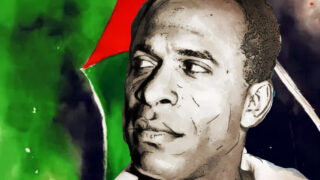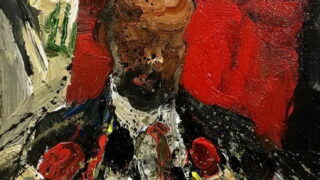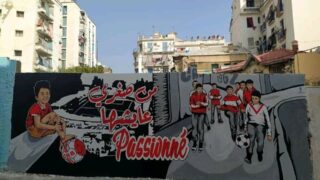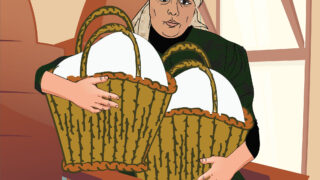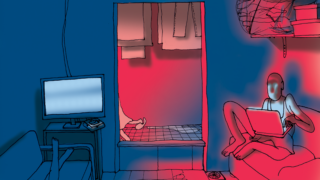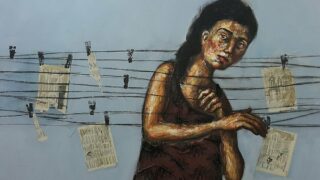
This publication has benefited from the support of the Rosa Luxemburg Foundation. This text may be reproduced in part or in full, provided the source is acknowledged.
Side by side, they stand there in solidarity every Wednesday of the week, close by the Republican palace in Algiers, by the residential neighbourhoods’ intersection in El Biar, Haïdra, and El Mouradiya. They stand out in a crowd as they whisper to each other while they hold the personal photographs of their loved ones like a third hand. Photos of children who were, one day, or one night, arrested from their own houses or in the middle of the street, and taken away by the State security forces. They have disappeared without a trace ever since.
The Mothers of the Disappeared have invented an Arabic word to express the indescribable: “Ghabbarouhom”, they say, or “they have industed them”, that is, “they have turned them (their children) into dust”. It is women who can create such an astonishing and precise metaphor to expose the yarn of lies and to question the disappearance of their family members: sons, normally, fathers, brothers, and husbands. And now, these images have settled into our human reality with cruel succinctness: a face, a name, and the date of forced disappearance of that person staring at us from that picture.
“I’ve stared long at every face line, but I could only see the reflection of my own feelings. Strange, isn’t it?” Writer Maïssa Bey shares, explaining how the photos of the disappeared, held by their families in public spaces, conjure up “(…) this fascinating mirror effect, directing our attention to where it should be – and they, that is, the families, do indeed ask for this attention, which is undoubtedly the only urge that keeps them going.” (1)
Such a confession, to which nobody dares object toady, is in and of itself an important event: they have shown the public what the Algerian authorities had wanted to keep hidden. The State in general and the media in specific still call it the “war against terrorism” against the “armed Islamic factions” that spread “terror and fear”.
Amidst unprecedented violence, the entire world called for punishing “the Islamic terrorists who have committed massacres in Algeria” by calling in another violent actor – the violence of the State itself in its administration of the period of post legislative elections that the Islamic Salvation Front (now banned) won in 1992. They asked them: “What have you done to our children?”. “What have you done to our husbands?” Wives chimed in, and soon enough it’ll be the sisters, swearing to their mothers on their dying beds, to continue the struggle. They’ll be asking in turn: “What have you done to our brothers?” All these families present their society with a mirror that reflects the real picture and shows the face of what has actually happened.
The Mothers of the Disappeared have invented an Arabic word to express the indescribable: “Ghabbarouhom”, they say, or “they have industed them”, that is, “they have turned them into dust”. It is women who can create such an astonishing and precise metaphor to expose the yarn of lies and to question the disappearance of their family members: sons, fathers, brothers, and husbands. And now, these images have settled into our human reality with cruel succinctness: a face, a name, and the date of forced disappearance of that person staring at us from that picture.
By questioning the past, these women in fact are questioning the present and the future, highlighting what’s been buried. They do so through an informal association. Even if since 1999 it’s been acting under the name “Collectif des Familles de Disparus en Algérie” (CFDA), founded in exile in Paris in order to amplify their voices before international human rights committees, its name remains, in the Algerian imaginary, the Association of the Mothers of the Disappeared.
Their association was founded in 1995-1996 and was composed of thousands of unknown women all across Algeria’s big cities. It was created at the peak of the state of emergency and extraordinary justice, declared in the name of the “war on terror” on the one hand, at the peak of violence of armed Islamic groups revolting against the State, and in between massacres and assassinations, while each party blamed the other for what was going on.
Today, and despite the multiple, sometimes violent, orders of silence and silencing, the association has managed to create its own narrative of this brutal “nameless war”, by the power of these women’s presence, holding pictures of an unbearable absence.
Amidst unprecedented violence, the entire world called for punishing “the Islamist terrorists who have committed massacres in Algeria” by calling in another violent actor – the violence of the State itself in its administration of the period of post legislative elections that the Islamic Salvation Front won in 1992.
Today, they resist, amidst profound political exclusion in the aftermath of this tragedy, attempts to bury the memory of the disappearing of their precious ones. As a form of a national reproach, they refuse to forget.
They fight for justice and truth. In fact, they refuse, with the last remnants of energy in their aging motherly bodies, to let the dust bury them alive with their children.
A beginning with no end
In the early 1990s, they didn’t know they’d become the “mothers of the disappeared”. They only thing they know for certain is that, on a day like today, and at a time like now, men in uniforms came in and arrested their son, husband, or brother.
They still remember every detail of it.
They know exactly when and what police, army, gendarmerie, or secret services came in to arrest that person who would later become “missing”.
They remember what they said, what happened, and how it happed, down to the last look they had exchanged with their loved ones, between son and mother, wife, sister, brother, and father – those who had witnessed that difficult night together. They know that that early morning moment had certainly happened and that, suddenly, one of their dearly beloved has become one of their dearly missed.
In the beginning, as absence grew longer, it would be the women who would start a research journey. Have they any other choice anyway but to look for that missing body? They repeat: “No tomb but no news either.”
They would go around, from police stations to barracks close by the place where their loved ones were locked up, they would look for the legal address of the detention centre before discovering that the names they were looking for weren’t even noted in the police records. Thus, they are obliged to venture into other paths, without any administrative or legal trace.
And so they’ve walked the unknown paths on their quest, as they discovered and uncovered one secret city after another, tracing the path towards disappearance. They knew which road they’ve taken their children by, and yet they insisted on wondering: what path is this that has turned our beloved ones into dust?
In between law courts and lawyers’ offices, families of the disappeared got to know and recognize each other. With time, they managed to create an association that has no legal standing but an unrivalled political weight and status. By breaking the silence, they were also breaking a taboo.
On this journey, they’ve discovered a whole other geography of their cities – in between police stations, barracks, multiple police force acronyms, and the colours of official uniforms. They now know the police force hierarchy, the names of notorious officers, and the military corps and police corps. They’ve moved between the court of justice and the public prosecution hallways, attempting the impossible: locating secret detention centres, which are, by definition, “invisible”.
Nothing had prepared them though for this geography of fear, and they hadn’t known yet that their quest would turn them into investigators. They would accumulate evidence and signs by the dark paths of disappearance. Rather, they have become the archivers of the forced disappearances in Algeria.
Memory, knowledge, and a fight to preserve the two, as these too could have also disappeared had it not been for the mother’s efforts.
Their work would then be very useful as input for the lawyers, journalists, national and international legal workers, and even for the government, in its attempts to obtain the families’ consensual silence under the excuse of “maintaining national peace”.
During the early years of armed violence (1992-1993), each family was living its tragedy on its own, before discovering that the disaster was, in fact, collective.
They know exactly what time, what police, army, gendarmerie, or secret service came in to arrest that person who would later become “missing”. They remember what they said, what happened, how it happened, down to the last look they had exchanged with their loved ones, between son and mother, wife, sister, brother, and father – those who had witnessed that difficult night together.
In between law courts and lawyers’ offices, families of the disappeared got to know and recognize each other. With time, they managed to create an association that has no legal standing but an unrivalled political weight and status. By breaking the silence, they were breaking a taboo: they’ve directly accused the security forces and the Algerian State of law violations, all the while claiming to defend the republic from the impending Islamist terror. By exposing and condemning the crime of the forced disappearances, they were actually changing the nature of the conflict; they’ve maintained this clandestine crime at the heart of public debate. By reassessing the political nature of the crime, they have been, and still are, holding Algeria’s ruling regime accountable for what has happened and demanding that the crime be given a name.
The State is guilty but not accountable!
To understand the particularity of this tragedy, we must recall that, unlike the case of forced disappearances in South America, the person that has been forcibly disappeared by State agents in Algeria would be facing, on top, a smear campaign: they are suspected “terrorists” or, even worse, “Islamists”. While it’s still difficult to determine the label or category of a person forcefully disappeared by the police and military forces, the geography of their disappearing follows the contours of the popular neighbourhoods that have, in their vast majority, voted for the Islamic Salvation Front in 1992 – that is, in the first pluralist parliamentary elections, which was supposed to lead Algeria from a single party regime to political pluralism.
While the official number of the forcefully disappeared, 6,146 persons, has been contested to be much higher by human rights organizations, it is still an enormous enough number to contradict the official discourse of “isolated cases” that the “out of control” individual State agents have carried out.
Cancelling the elections (by order of the military leadership and against the advice of President Chadli Benjedid, who had led this reform initiative that ended in failure) initiated the first of waves of violence, so unimaginable that neither the police force nor the military forces could have foreseen, nor the “Islamist rebellion” for that matter, fragmented into a form of multiple armed groups, whose actions lacked both leadership and political vision. The two parties placed all their efforts into influencing public convictions and taking stands against one another, with each accusing the other of committing the ugliest atrocities.
An Incomplete Algerian Symphony
28-02-2021
In this context, the disappeared are stuck between two types of violence and two different narratives of that violence. They thus become collateral victims whose identity is difficult to determine within these popular neighbourhoods, which were already accused, by supporters of the “compromised” republic, of being advocates of the Islamic Salvation Front.
The biggest challenge that faces the families of the disappeared lies in convincing the public opinion – already won over by the official and dominant narratives, that their children have never joined the armed groups. “The phenomenon of forced disappearances targeted civilians who were already under the threat of both armed Islamist groups and the State security services. Contrary to official narratives, reiterated to the public and international human rights authorities, the missing were not armed terrorists. They were arrested in their homes, public spaces, workplaces, or randomly, while going about their daily lives.” (2)
It is difficult to estimate the actual number of the missing, but, according to the civil reconciliation plan (laid out by the successive governments and presidents between 1995 and 2006, 11 years in between the Rahma (Mercy) law, which proposed having that the armed groups descend from the mountains and be granted formal pardon after their repentance, and the Charter for National Peace and Reconciliation, adopted on December 29th, 2005, which would put an official halt to acts of violence), the families of the missing would be automatically recognized as part of the arrangements put in place.
A sentence in one article summarizes this process concisely: “Having denied the forced disappearances, the Executive Authorities established a committee specialised in ‘treating’ the question of the ‘missing Algerians’ in 2003. The committee was responsible for determining forced disappearances by appointing competent authorities to investigate them, eventually informing the concerned families of the investigation’s outcome.” (3)
It was Farouk Ksentini, the president of the National Consultative Commission for the Promotion and Protection of Human Rights (CNCPPDH) who presented the results: eighteen months later, he announced that the committee acknowledges 6,146 cases of disappearances by “independent State agents”. He added that “while the State may be considered responsible for its inability to have protected some of its Algerian citizens, it is still not guilty – due to a ruptured chain of command or hierarchy, which has enabled some State agents to act individually.” (4)
His long quote was summed up by the Algerian public opinion in one succinct statement: “The State is guilty but not accountable”.
Two years later, with the adoption and approval of the National Charter in 2005, the same spirit prevailed, which was a legal expression devised to put an end to what it called “the national tragedy.”
“The 2005 charter twists and reduces the responsibilities at hand and prevents the development of any critical thinking around the 10 years of deadly waves of violence. “The national tragedy,” as articulated by the Algerian State, has no room for analysis or critique of the aftermath of shock, the State’s responsibility, or the security forces and Islamist terrorism. In its current version, it blocks any kind of transitional justice or relief for the victims”, as historian Karima Dirèche Slimani sums it up. (5)
Every Wednesday, the mothers of the missing still gather, side by side, in solidarity, their numbers dwindling with time. They carry on testifying: without a body, the dead aren’t dead; without a burial, the dead haven’t died yet – not as long as they’re denied a hole in the earth from which they could say: “Here I am”. With this demand, the mothers of the disappeared do not recount the past only, but also the future.
An inexhaustible and indefatigable debate. However, it is important to note that, amidst this long journey, while the official number of the forcefully disappeared, 6,146 persons, has been contested to be much higher by human rights organizations, it is still an enormous enough number to contradict the official theory of “isolated cases” that the “out of control” individual State agents have carried out.
Such a figure, in and of itself, is capable of exposing a real system of coercion anyway. The figure includes a massive number of concerned families, many bodies locked up in fridges, a large number of State agents, many mechanisms and vehicles, lots of uniforms, and lots of secret detention centres. These “lots and lots” are themselves evidence of a real machine of oppression that has infringed on any legality and strongly resembles an organized strategy of terrorism.
This admission, however measured and tailored to suit the State, has vindicated the missing persons’ families and relieved them of the shameful stigma of being “families of the butchers”. It definitively welcomed the families who were victims of forced disappearances into the side of the victims of what is now called “the national tragedy”. Finally, the mothers of the missing have symbolically retrieved their children, and with that, the families were able to return to the national community from which they were excluded.
This had finally given them the right to ask: And now, will you tell us where the missing persons of this “national tragedy” are? These mothers have been asking the question despite the law that prohibits alluding to tragedies, at the risk of fines and imprisonment, in the name of amnesty / amnesia.
Every Wednesday, then, the mothers of the missing still gather, side by side, in solidarity, their numbers dwindling with time; they carry on testifying: without a body, the dead aren’t dead; without a burial, the dead haven’t died yet – not as long as they’re denied even a hole in the earth, from which they could say: “Here I am. Here we are”.
As this is their demand, the mothers of the disappeared do not recount the past only, but also the future. They are the tortured consciousness of the 1990s Algeria. They demand their right to know and they fight oblivion, silence, lies and State practices. They call out all the political and social powers that have used military force in the name of “protecting the republic” in 1992 (ever since the state of extraordinary justice and the state of emergency had been declared, never lifted until February 2011) and chose silence because, as per their words at the time, “you cannot make an omelette without cracking some eggs.”
The mothers of the missing remind us today that even the past has a future: “Here, perhaps, lies one of the most important victories of the families of the detained-disappeared,” writes Antonia Garcia Castro from Chile, “ in their ability to make the forced disappearances into a mirror in which each of us can see themselves through the eyes of future generations.” (6)
The content of this publication is the sole responsibility of Assafir Al-Arabi and Rosa Luxemburg Foundation cannot accept any liability for it.
Translated from Arabic by Yasmine Haj
Published in Assafir Al-Arabi on 10/04/2022
1- A Fleur de silence, Anaïs Pachabézian, Maïssa Bey, ed. Barzakh, 2011.
2- « Les disparitions forcées en Algérie : un crime contre l’humanité, Collectif des Famille de disparus en Algérie, CFDA, février 2013.
3- L’Algérie « post décennie noire » : de l’imposition de l’impunité à la revendication de la justice transitionnelle, Morgane Jouaret, https://d@oi.org/10.4000/anneemaghreb.10017
4- Idem.
5- Algérie : La « décennie noire », une mémoire interdite, par Karima Dirèche Slimani, Afrique. https://information.tv5monde.com
6- Hors-thèmes : la mémoire des survivants et la révolte des ombres : les disparus dans la société chilienne (1973-1995), Antonia Garcia Castro https://doi.org/10.4000/conflits.2163


